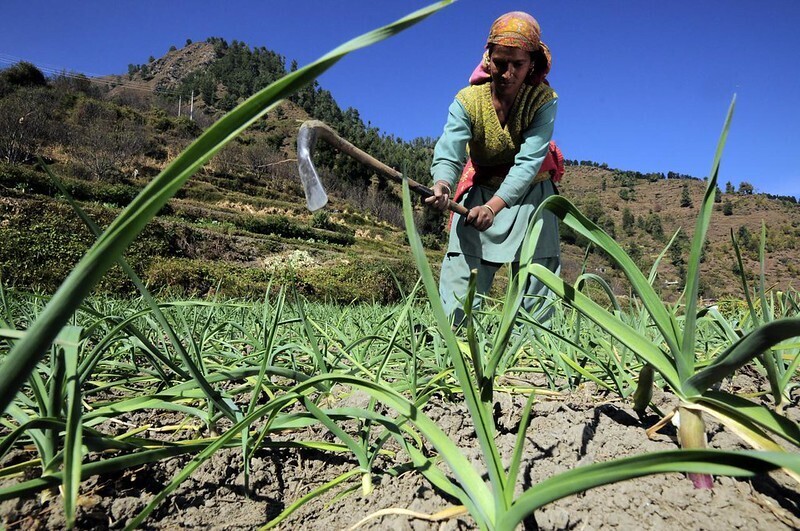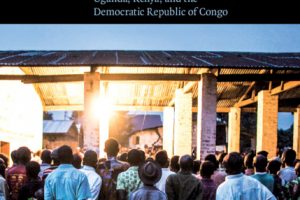Commodified Climate Solutions: The Ethical Dilemma of Adaptation and Resilience Investments (IIL Symposium)

Source: World Economic Forum
This piece is part of the American Branch’s second blogging symposium, examining the ILW 2024 theme of ‘Powerless law or law for the powerless?’ from an International Investment Law perspective. This symposium is sponsored by the International Investment Law Committee, but published works are solely those of the authors.
Commodified Climate Solutions: The Ethical Dilemma of Adaptation and Resilience Investments
by Champion Olatunji*
Introduction
The world is experiencing increasing climate-related disasters, such as droughts, famines, and rising sea levels. To reverse this problem, the Intergovernmental Panel on Climate Change (IPCC) called for new pathways to reduce vulnerabilities to climate impacts and development through adaptation and resilience, which has become a critical subject in global climate action discussions.
However, profit increasingly shapes efforts to adapt and build resilience rather than fairness. Companies and investors are turning adaptation and resilience into business opportunities, often at the expense of vulnerable communities and ethical outcomes. This blog investigates how these financial priorities conflict with the need for equitable climate solutions and argues for a shift to frameworks that put justice first.
The IPCC states that we should consider adaptation as a response strategy to anticipate and cope with impacts that cannot be avoided under different climate change scenarios. Similarly, resilience refers to the capacity to prepare for, respond to, and recover from the impacts of hazardous climatic events while incurring minimal damage to societal well-being, the economy, and the environment, including at the local, subnational, national, regional, and international levels. Together, these strategies form a necessary framework for safeguarding vulnerable communities against the worsening impacts of climate change. Implementing adaptation and resilience measures, however, requires substantial financial investment. This need appears in Article 2.1 (c) of the Paris Agreement, which calls for aligning financial flows with low-carbon and climate-resilient development.
In recent years, adaptation and resilience (A&R) investments have emerged as a frontier for institutional investors, mostly from wealthier nations, and blended finance platforms. Across sectors like insurance, agriculture, energy, and healthcare, these investments are increasingly seen not just as environmental necessities but as lucrative opportunities.
However, this commodification of climate solutions raises profound ethical questions: Are these profit-driven investments reinforcing global inequalities rather than addressing them? Are the most vulnerable communities being left behind in the race to monetize climate solutions? Can we rethink the role of international investment law to ensure that (A&R) investments uphold the principles of climate justice rather than perpetuate global inequalities?
The Commodification of Adaptation and Resilience as Climate Solutions
Unlike other investment models well understood by financial institutions, adaptation and resilience (A&R) measures face challenges that limit their uptake. The evidence from the 2023 publication from Race to Resilience revealed some key reasons for the low investment in adaptation. These include perceptions of low profitability, limited information availability, and the long-term horizon of projects (often spanning 10-20 years).
Despite these barriers, the commodification of A&R solutions is on the rise. Commodification refers to how climate solutions, designed to address critical risks, are commercialized and marketed primarily for profit rather than public interest. These solutions include technologies and services to reduce greenhouse gas emissions, increase energy efficiency, or promote sustainable practices.
Some examples of commodified A&R solutions include:
– Climate-resilient real estate, which focuses on developments designed to withstand climate risks like flooding and hurricanes, commands premium market values;
– Flood insurance products that leverage advanced climate risk models to determine coverage and premiums;
– Disaster recovery technologies such as satellite imagery, geospatial mapping, and risk modeling tools that are commercialized to support governments and businesses in disaster preparedness; and
– Smart grids and energy upgrades that provide infrastructure improvements tailored to extreme weather conditions, ensuring energy continuity and efficiency.
One key factor driving this trend is the potential financial returns in developing markets. A 2022 report by the World Economic Forum (WEF) highlighted that the market for adaptation solutions in developing countries could reach $2 trillion annually by 2026. The report framed adaptation as an “enormous opportunity,” encouraging private sector actors to “place their bets” on A&R solutions, particularly in regions most vulnerable to climate impacts. By tying climate responsibilities to financial returns, businesses increasingly view climate change as an opportunity for wealth creation, often at the expense of broader equity and justice concerns.
While the intent to scale up adaptation is well-meaning, the growing focus on profitability risks sidelining the equitable and inclusive dimensions essential to climate justice. The inherent ethical concern in this commodified approach is evident as financial actors tie climate adaptation into a business-first endeavor. This approach may detract from the systemic changes required to address climate justice, equity, and resilience for the most vulnerable communities.
While these solutions address critical risks, their development and deployment are shaped by market incentives rather than equitable frameworks. Without deliberate efforts to integrate justice and equity, commodification may exacerbate inequalities in climate vulnerability.
Investment Drivers Responsible for Commodifying A&R Climate Solutions
Institutional investors and blended finance platforms increasingly recognize the financial opportunities within climate adaptation. Reports from major players such as BlackRock suggest that A&R investments are gaining traction because of the following:
– Hedging Against Climate Risks: Adaptation investments mitigate climate-related vulnerabilities, providing stability in diversified portfolios.
– Increasing Demand: Rising climate impacts drive the need for resilience solutions across agriculture, energy, and infrastructure sectors.
– Enhanced Project Returns: Incorporating climate risk assumptions (e.g., wildfire risk in energy infrastructure) can increase profitability.
Blended finance models, such as those employed by Climate Fund Managers Investor Two, are packaging A&R solutions as bankable projects to attract private capital. These approaches de-risk investments and promote private sector participation, further normalizing the commodification of resilience.
Recent studies, such as one from Harvard Business School, reflect a broader shift in corporate strategy. U.S. public companies are not only responding to climate risks but also actively framing them as business opportunities. This transformation signals the growing alignment between climate solutions and financial objectives, albeit with risks of prioritizing short-term returns over long-term equity.
Ethical Dilemmas of Commodifying A&R Climate Solutions
In a bid to raise the inherent issues in this new strategy among financial actors or private investors, the commodification of climate solutions could be problematic. For instance, in emerging markets, investments are sometimes directed into projects like large-scale solar or wind farms that benefit from tax incentives or land concessions but do not necessarily support local adaptation strategies or respect indigenous land rights. Conversely, in developed economies, investments might not align with national decarbonization targets, focusing instead on short-term profitability.
Some of the ethical dilemmas that arise from the commodification of climate solutions include:
– Misalignment with climate goals – If investments focus more on financial returns than on actual climate resilience or emission reduction, they could undermine global climate goals and the Nationally Determined Contributions (NDCs) under Article 4 of the Paris Agreement which embodies efforts by each country to reduce national emissions and adapt to the impacts of climate change.
– Equity Gaps – Here, the differential vulnerability and exposure of vulnerable groups, communities, and ecosystems to climate hazards is already recognized under the UNFCCC. As such, guidance on A&R action requires actual solutions for such groups and ecosystems. Still, when the motive for prioritizing these communities is profit-driven, resources may be shifted to wealthier regions and consumers, leaving these communities to bear the burden of the climate crisis.
– Climate Injustice – The commodification of A&R might exacerbate global inequities. Wealthier countries or communities could afford to invest in and benefit from these solutions. At the same time, developing nations or marginalized groups might be left with insufficient resources to adapt, thus widening the gap in climate resilience.
– Accountability and Responsibility – Commodification raises the question of who should be held accountable for ensuring that A&R investments are ethical and equitable. Should it be investors, governments, or international bodies? And how can we ensure that these entities act in the interest of climate justice?
– Risk of Greenwashing – With the rush to capitalize on climate solutions, there is a risk of greenwashing. Companies might overstate or misrepresent their contributions to A&R, leading to a false sense of progress in climate action.
– Future Generations – Today’s decisions regarding A&R investments will have long-term implications. We have an ethical responsibility to ensure these investments do not just serve current financial interests but also safeguard the environmental conditions for future generations.
This blog recognizes that markets are effective mechanisms for distributing many goods and services and rewarding returns on investment, but also acknowledges that market operations are not inherently devoid of moral considerations. Creating new forms of commodification creates new social and environmental problems. As a market investment strategy over actual environmental solutions, this approach tends to internalize the economic imperatives of market activities, which is a strategy that is becoming obvious in the way these solutions are generally promoted as one of the effective means for private investors and blended finance platforms to contribute to decarbonization.
Reforming Investments in Climate Solutions
Reforming investments in climate solutions through investment law internationally is a complex challenge. Some parts of these reforms are now front-burner issues among investment law scholars, such as the dispute settlement process and protection of foreign investors’ expectations. Yet, there is also a need to start carving out a new framework for investments in climate solutions that would not be treated as marketable assets.
For example, preferential treatment for foreign investment tends to arise from differences in overall approaches for balancing public and private interests, applicable substantive rules, and legal remedies, including damages awarded. To this end, South Africa’s constitution, for example, requires payment of ‘just and equitable compensation’, which must involve ‘an equitable balance between the public interest and the interests of those affected. This has prompted treaty drafting shifts, including more qualified language on indirect expropriation and environmental exceptions. For instance, the same approach can be adopted by adding new standards, especially in international treaties, to prevent the commodification of climate solutions.
As practitioners address specific climate finance issues through international law, especially in developing countries, they must also consider the evolving strategies employed by financial players who view the climate crisis as an economic opportunity. This is evident in how they frame adaptation and resilience (A&R) solutions and structure investments. Therefore, the United Nations Framework Convention on Climate Change (UNFCCC), investment law practitioners, and institutions should incorporate this emerging issue into their review of international investment treaties and laws in the context of climate change.
The already apparent inequities in these new commodified solutions raise concerns about the role of international investment law. Carving out appropriate new standards in investment treaties would require considering equitable access, prioritization of vulnerable communities, and integration of justice considerations into the market mechanisms. This means incorporating clauses into investment treaties that ensure investments contribute to adaptation and resilience objectives. Moreover, such clauses should mandate community engagement wherein financial gains from these investments are distributed equitably in the community. They should also provide ethical investment incentives whereby climate solutions that prioritize the fundamental goal of sustainability over pure profit would receive tax benefits or recognition in global sustainability efforts.
Conclusion
The current investment law framework needs to be rethought to ensure that investments are aligned with decarbonization goals and the NDC priorities of host countries. As discussed throughout this blog, commodifying climate solutions within existing investment structures undermines justice-oriented approaches and exacerbates climate vulnerabilities. In response to this critical issue, this paper has proposed that carving out new frameworks in the current investment law model and binding them would prevent investments in climate solutions from being treated solely as marketable assets.
As detailed above, this framework reimagines A&R by centering on equity, ethical responsibility, and systemic transformation. This would help transform climate investments from mere economic opportunities, susceptible to the pitfalls of commodification analyzed earlier, into actual solutions for climate change governance. These reforms, alongside the current efforts of international law practitioners, would directly address the concerns raised regarding unchecked capital accumulation, commodification, pollution, and deepening socioeconomic inequality.
 *Champion Olatunji has extensive experience working with both for-profit and non-profit organizations in the United States, serving in various capacities as a researcher and consultant on sustainable cross-border investment, climate change, and business law. His work has been published in peer-reviewed journals. He holds an LLM degree from Duke University School of Law and is a Clean Energy Leadership Institute (CELI) Fellow in Washington, DC.
*Champion Olatunji has extensive experience working with both for-profit and non-profit organizations in the United States, serving in various capacities as a researcher and consultant on sustainable cross-border investment, climate change, and business law. His work has been published in peer-reviewed journals. He holds an LLM degree from Duke University School of Law and is a Clean Energy Leadership Institute (CELI) Fellow in Washington, DC.



